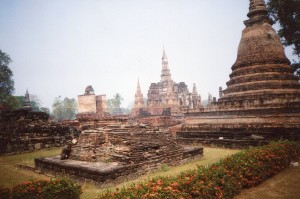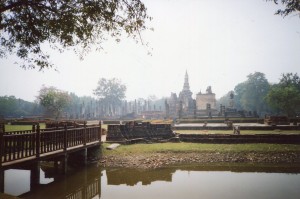Angkor Wat often gets top billing in Southeast Asia. It was as magnificent as I had expected, but exploring Sukhothai afterwards was just as rewarding. It seems more soft-hearted than Angkor Wat’s statements about the king’s divine power. At least Sukhothai’s greatest monarch wanted you to think so.
Sukhothai was founded in the mid 13th century by a king called Si Intharathit. Its third king, Ramkhamhaeng developed it, and he’s credited with a masterpiece of real estate salesmanship.
The Khmers had ruled more than half of Thailand since the eleventh century. Thais had gained independence in the thirteenth, and were forming their own kingdoms.
The name Sukhothai means Dawn of Happiness, and a stele with writing on four sides describes a place that seems so idyllic that anyone would want to live there.
It boasts that anyone can come to the palace, ring a bell and discuss problems with the king. This might have been an elbow in the Khmer empire’s ribs. In 1297, a Chinese merchant in Angkor said that royal appearances were impersonal rituals in which people had to touch the grounds with their foreheads.
The stele states that Sukhothai’s people have many reasons for joy. The land is full of mango groves, betel groves and fields for coconut, jackfruit, tamarind and areca. Those who cultivate them can keep them.
People hold cheerful religious celebrations and walk in processions singing and playing music.
But the stele’s authenticity has recently been questioned. It might have been written in the middle of the nineteenth century, when King Mongkut was boosting the monarchy’s image. He restored many old sites, and might have fabricated icons of royal benevolence.
But no matter. Many Thais are taught that Sukhothai is the wellspring of their culture.
Thai culture’s origins are actually more complex and rich–many societies converged to create some of the most pleasant art in the world.
But Sukhothai has remained an ideal of graceful art forms and behavior. Its art isn’t as sensationalistic as Angkor Wat is, but if you spend some time here, you might find it even more entrancing. We’ll explore it more in Sukhothai.



Comments on this entry are closed.